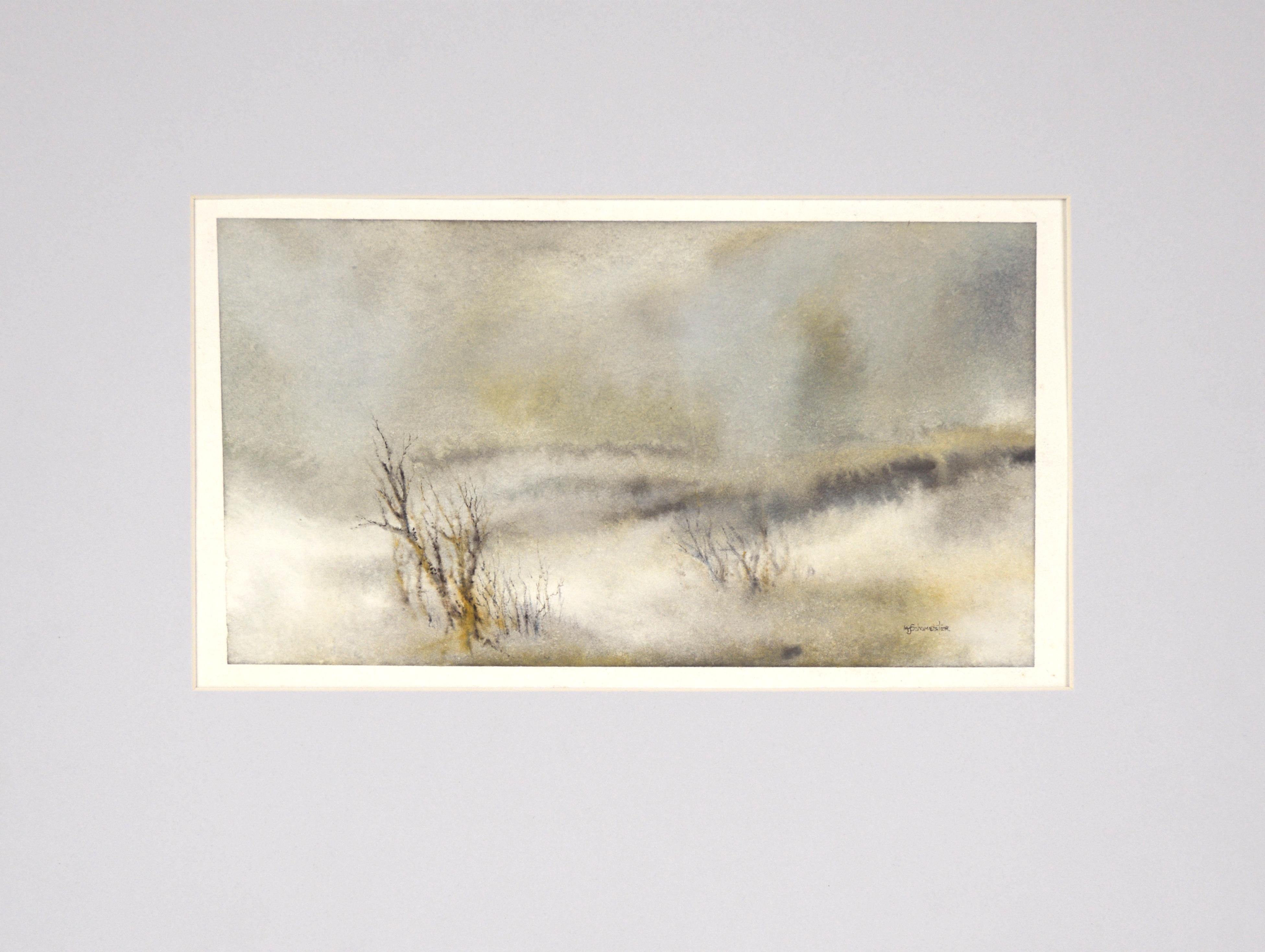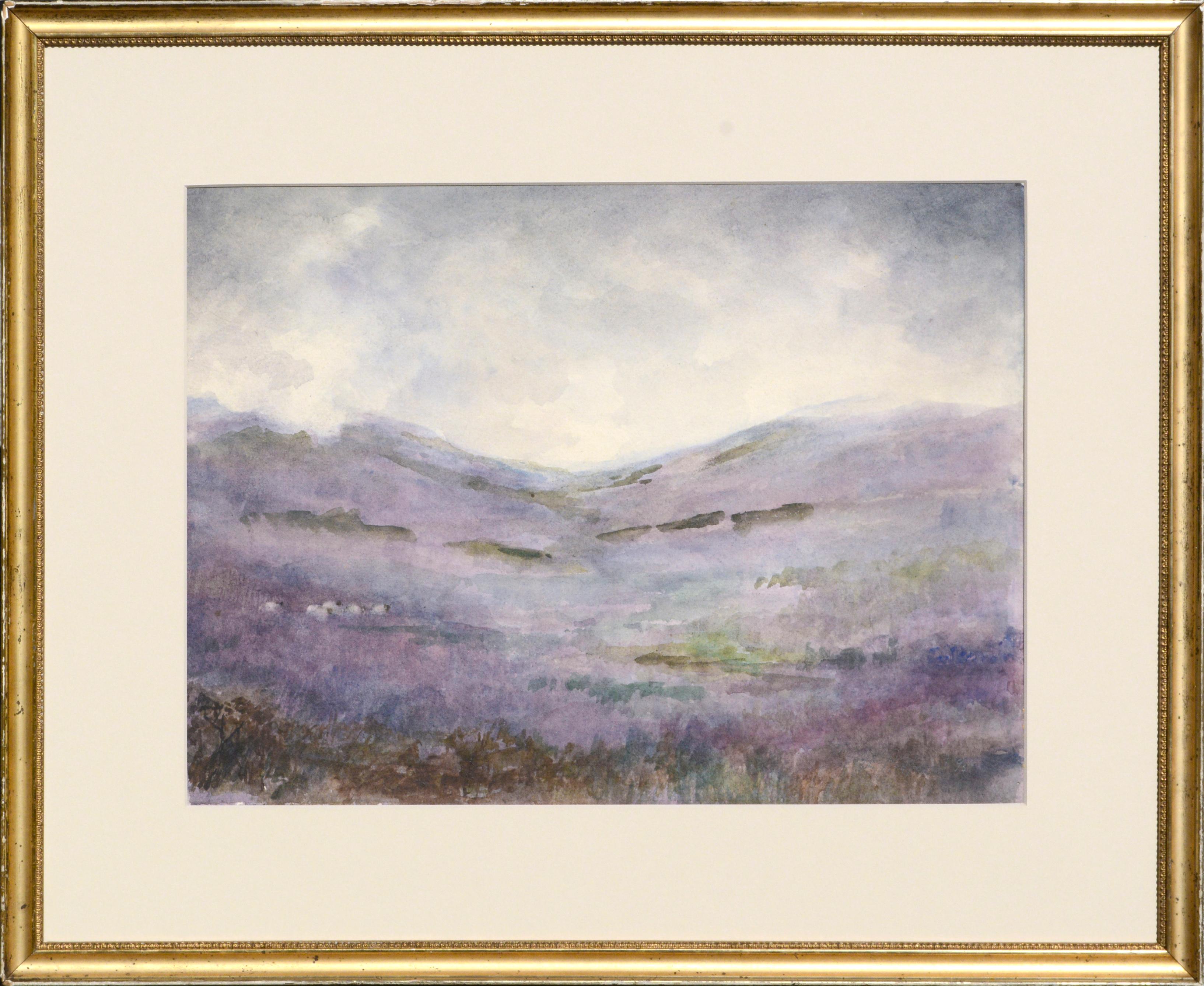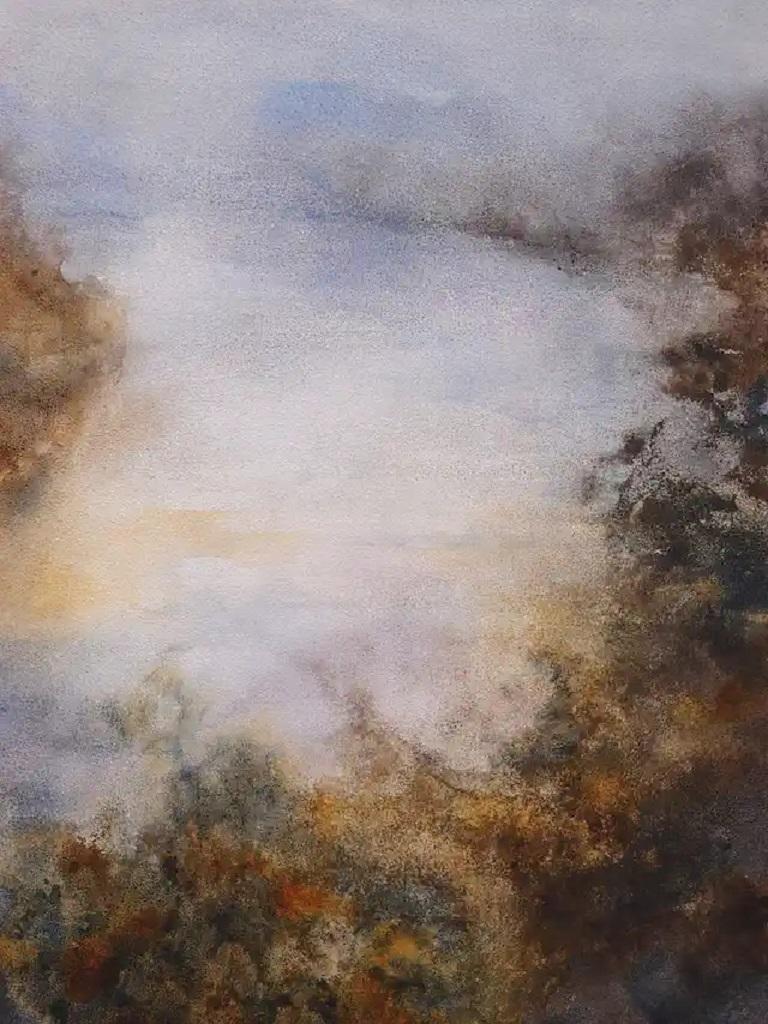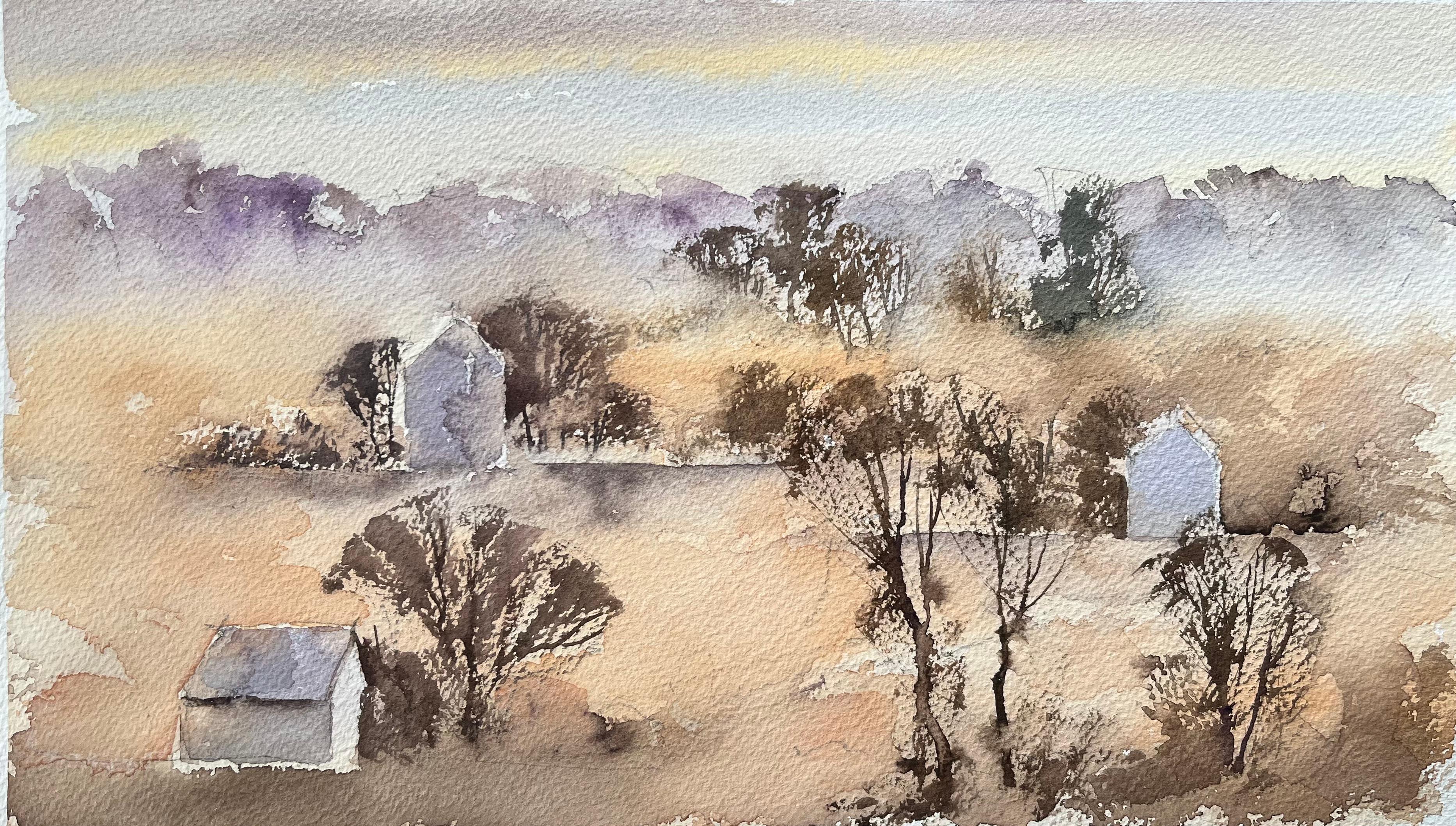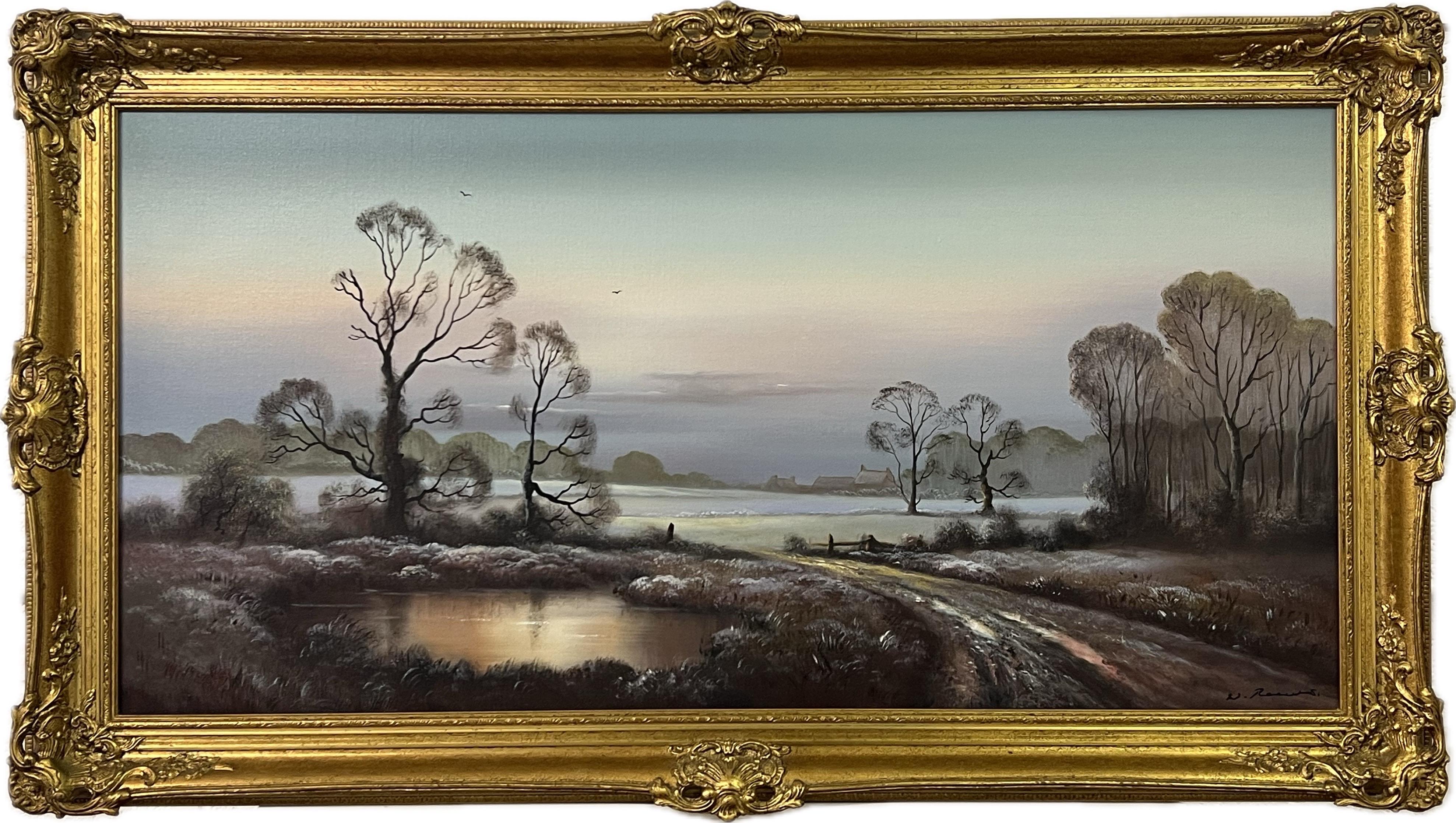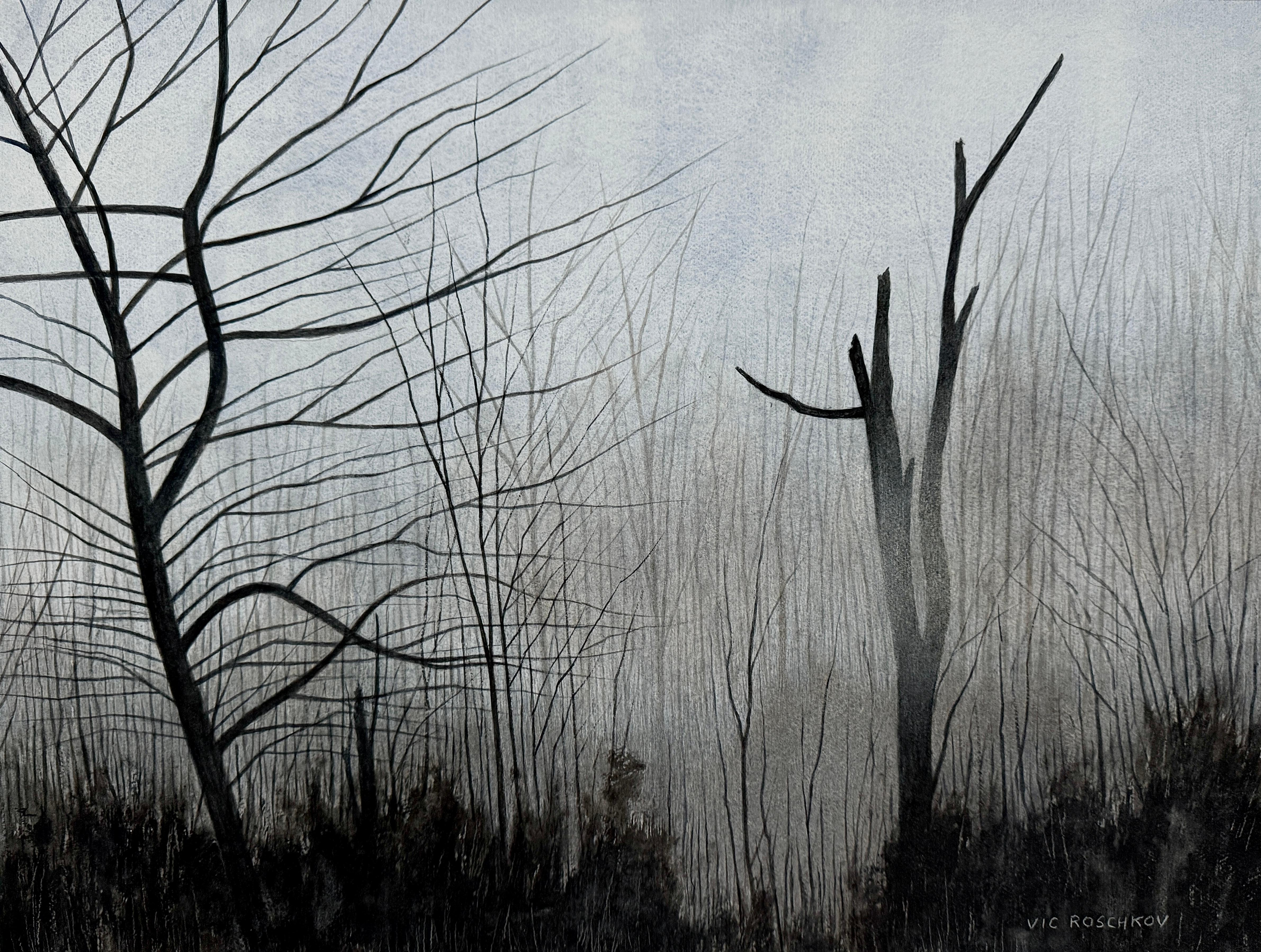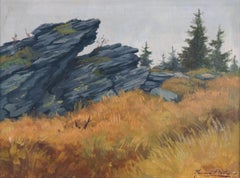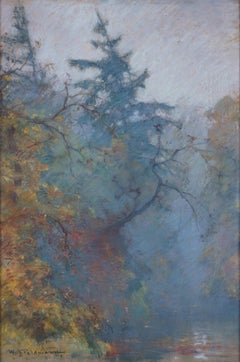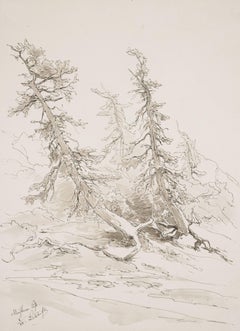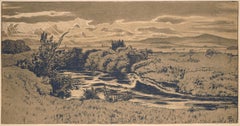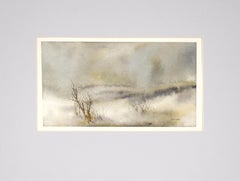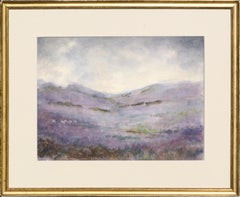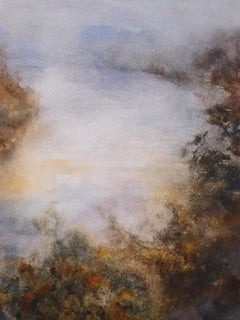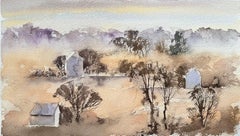Items Similar to High Moorland Landscape in the fog - The world as a transcendent phenomenon -
Want more images or videos?
Request additional images or videos from the seller
1 of 8
High Moorland Landscape in the fog - The world as a transcendent phenomenon -
$1,714.29
$2,142.8720% Off
£1,274.19
£1,592.7320% Off
€1,440
€1,80020% Off
CA$2,366.97
CA$2,958.7120% Off
A$2,624.79
A$3,280.9920% Off
CHF 1,379.13
CHF 1,723.9220% Off
MX$32,070.51
MX$40,088.1320% Off
NOK 17,254.85
NOK 21,568.5620% Off
SEK 16,196.62
SEK 20,245.7820% Off
DKK 10,964.88
DKK 13,706.1020% Off
About the Item
Charles Edward Brittan Jr (1870 Plymouth - 1949). High moor landscape in the fog. Gouache, signed at lower left "Charles E. Brittan", 18 x 34.5 cm (passepartout), 45 x 62 cm (frame). Framed under glass.
- The world as a transcendent phenomenon -
About the artwork
We view the landscape as if from a wide angle. The sparse vegetation of Scottish highland heather - the field of vision, so to speak - expands into the picture in a wedge shape, only to immediately exceed the limits of the picture to the side. This widening of the field of vision makes the objects in the very near foreground seem distant, even though they are almost tangible against the visibly diffuse landscape. The withdrawal of perspective gives the landscape a visionary character, which is reinforced by the bluish mist that spreads into the foreground and by the sheep, which visibly lose their visual reference points as they move further away. This visionary quality culminates in the appearance of the elongated, gently curving silhouettes of the mountains and the light phenomena that appear above them, which seem as close to the present as the diffuse yellowish-brown foreground.
Here Charles Edward Brittan congenially implements the Romantic pictorial idea developed by Caspar David Friedrich in his metaphysical landscape paintings, which took landscape painting to a whole new level. The gaze directed into the picture is blurred, so that from the realm beyond visual perception, something is able to form on the edge of perception, opening up a perception of the supersensible sphere.
About the artist
Trained by his father of the same name, Charles Edward Brittan painted mainly landscapes and animals, but also worked as an illustrator. He worked mainly in Devon, where he produced his most cherished views of Dartmoor, capturing its varied and characteristic atmosphere.
Selected Bibliography
Huon L. Mallalieu: The dictionary of British watercolour artists up to 1920, Woodbridge 1976.
Melissa Hardie (Hg.): Artists in Newlyn and West Cornwall. 1880 - 1940, Bristol 2009.
GERMAN VERSION
Charles Edward Brittan jun. (1870 Plymouth - 1949). Hochmoorlandschaft im Nebel. Gouache, signiert unten links "Charles E. Brittan", 18 x 34,5 cm (Passepartout Innenmaß), 45 x 62 cm (Rahmen). Unter Glas gerahmt.
- Die Welt als transzendente Erscheinung -
zum Werk
Der Betrachter blickt wie in einer Weitwinkelperspektive auf die Landschaft. Dabei weitet sich der spärliche Bewuchs des schottischen Hochlandheidekrauts - gleichsam stellvertretend für das Sehfeld - keilförmig in das Bild hinein, um die Bildgrenzen sogleich seitlich zu übersteigen. Durch diese Weitung des Blicks wirken bereits die Gegenstände des allernächsten Vordergrundes entfernt, obwohl sie vor der zusehends diffundierenden Landschaft beinahe greifbar scheinen. Der perspektivisch erwirkte Entzug verleiht der Landschaft einen visionären Charakter, der durch die bläulichen, sich bis in den Vordergrund hinein verbreitenden Nebelschwaden ebenso verstärkt wird wie durch die Schafe, die sich mit zunehmender Entfernung zusehends als visuelle Anhaltspunkte verlieren. Dieser visionäre Zug kulminiert schließlich in der Erscheinung der langgezogenen, weich geschwungenen Bergsilhouetten und den sich darüber offenbarenden Lichtphänomenen, die ebenso nahe gegenwärtig wirken wie der diffundierende gelb-brauntonige Vordergrund.
Auf kongeniale Weise setzt Charles Edward Brittan hier Bildidee der Romantik um, die Caspar David Friedrich in seinen, die Landschaftsmalerei auf ein ganz neues Niveau hebenden metaphysischen Landschaftsbildern entwickelt hat. Der in das Bild hineingerichtete Blick verschwimmt, damit sich aus dem der visuellen Wahrnehmung jenseitigen Bereich heraus etwas an der Grenze der Wahrnehmung zu formieren vermag, das eine Ahndung der übersinnlichen Sphäre eröffnet.
zum Künstler
Charles Edward Brittan wurde von seinem gleichnamigen Vater ausgebildet und malte vor allem Landschaftsbilder und Tierdarstellungen, war darüber hinaus aber auch als Illustrator tätig. Vorwiegend in Devon ansässig, schuf er dort seine besonders geschätzten Ansichten des Dartmoores, dessen vielfältige charakteristische Atmosphäre er bildlich einzufangen verstand.
Auswahlbibliographie
Huon L. Mallalieu: The dictionary of British watercolour artists up to 1920, Woodbridge 1976.
Melissa Hardie (Hg.): Artists in Newlyn and West Cornwall. 1880 - 1940, Bristol 2009.
- Attributed to:Charles Edward Brittan (1870 - 1949, British)
- Dimensions:Height: 17.72 in (45 cm)Width: 24.41 in (62 cm)Depth: 1.58 in (4 cm)
- Medium:
- Movement & Style:
- Period:
- Condition:
- Gallery Location:Berlin, DE
- Reference Number:1stDibs: LU2438212379362
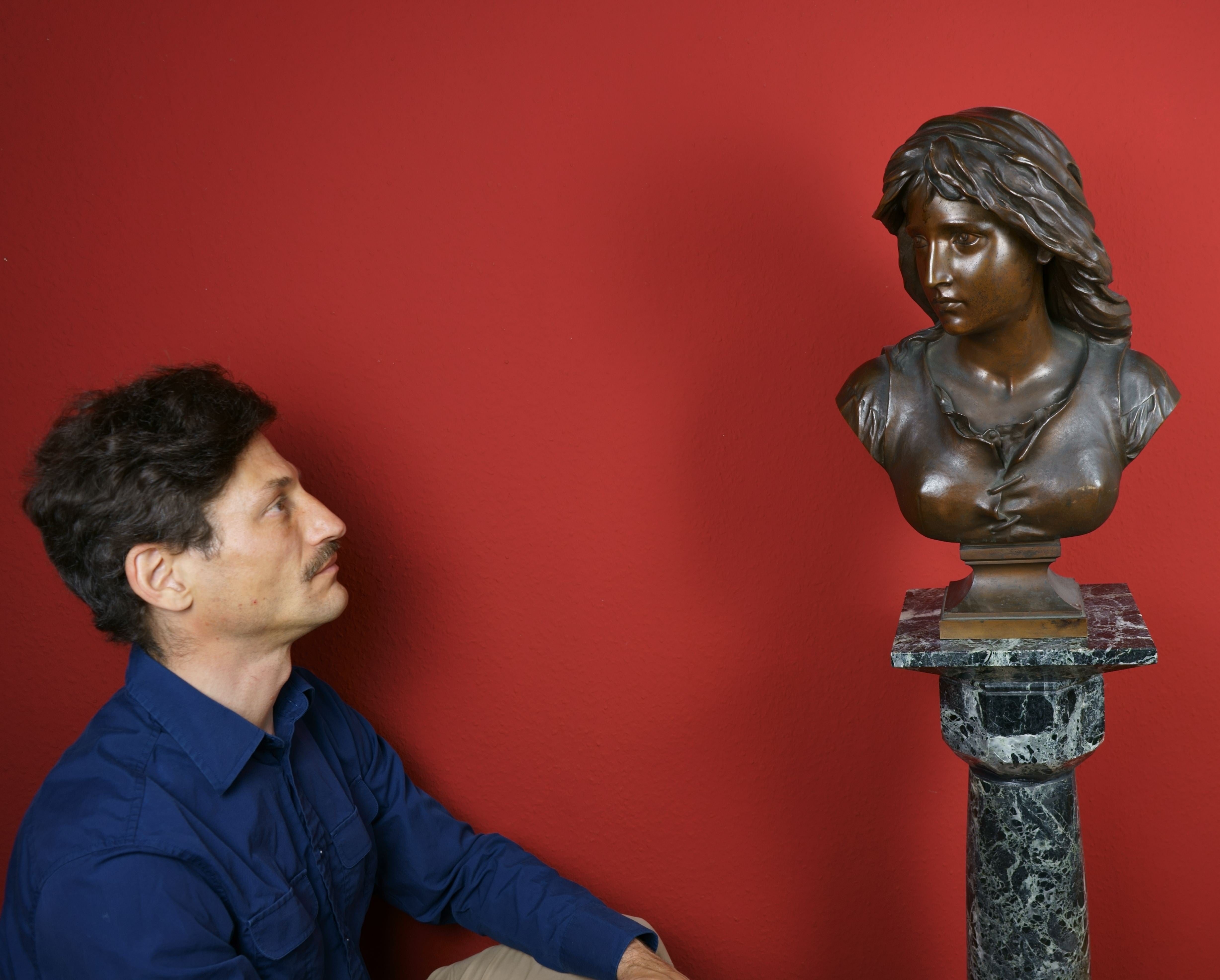
About the Seller
5.0
Vetted Professional Seller
Every seller passes strict standards for authenticity and reliability
Established in 2014
1stDibs seller since 2023
21 sales on 1stDibs
- ShippingRetrieving quote...Shipping from: Berlin, Germany
- Return Policy
Authenticity Guarantee
In the unlikely event there’s an issue with an item’s authenticity, contact us within 1 year for a full refund. DetailsMoney-Back Guarantee
If your item is not as described, is damaged in transit, or does not arrive, contact us within 7 days for a full refund. Details24-Hour Cancellation
You have a 24-hour grace period in which to reconsider your purchase, with no questions asked.Vetted Professional Sellers
Our world-class sellers must adhere to strict standards for service and quality, maintaining the integrity of our listings.Price-Match Guarantee
If you find that a seller listed the same item for a lower price elsewhere, we’ll match it.Trusted Global Delivery
Our best-in-class carrier network provides specialized shipping options worldwide, including custom delivery.More From This Seller
View AllLow Mountain Landscape with Rocks - The mystery of an inconspicuous place -
Located in Berlin, DE
Heinz Roder (1895-1965), Low Mountain Landscape with Rocks, oil on painting cardboard, 30 x 40 cm (visual size), 40 x 50 cm (frame), signed and dated "[19]34" at lower right. In a de...
Category
1930s Landscape Paintings
Materials
Cardboard
Impressionist Autumn Landscape with Lake / - Diffuse Concretion -
Located in Berlin, DE
Wilhelm Feldmann (1859 Lüneburg - 1932 Lübeck), Impressionist autumn landscape with lake, around 1905. Pastel on cardboard, 46 cm x 31 cm (inside dimension), 52 cm x 37 cm (frame), s...
Category
Early 1900s Impressionist Landscape Paintings
Materials
Gouache
Woodland / - The Inner Drama of the Landscape -
Located in Berlin, DE
Eduard Peithner von Lichtenfels (1833 Vienna - 1913 Berlin), Woodland, 1884. Watercolor and pen and ink on drawing paper, 30.4 cm x 22.5 cm, signed, dated and inscribed by the artist...
Category
1880s Landscape Drawings and Watercolors
Materials
Paper
At the pond / - The longing of the landscape -
Located in Berlin, DE
Hans Thoma (1839 Bernau - 1924 Karlsruhe), At the pond, 1897. Algraph on strong wove paper, published by Breitkopf und Härtel in Leipzig as ‘Zeitgenössisches Kunstblatt Nr. 148’, 23....
Category
1890s Realist Figurative Prints
Materials
Paper
In the forest of Durlach - Quiet ripple in a secret place -
Located in Berlin, DE
Franz Xaver Graessel (1861 Oberasbach/Baden - 1948 Emmering). In the forest of Durlach. 1881. Pencil drawing, heightened with white, on grey-green paper. 33 x 41.7 cm. Signed, dated and inscribed by the artist himself: 'Franz Graessel. Durlach, 12 April 1881".
About the artwork
The drawing depicts a view of the woods which, as if sharpening the visual focus, remains diffuse at the edges and does not allow the viewer to locate himself in the picture. As a result, the landscape appears to be an apparition, but at the same time it is given real substance by the solidity of the massive arched bridge made of quarry stone. As the main motif of the painting, the bridge, which blends in with nature like an archaic relic, also acts as a visual guide, drawing attention to the white, raised waters of the stream and the surrounding vegetation. The diffusion of perception that takes place there, however, draws the eye back to the bridge and thus to the overall view. This movement initiating a constant alternation of diffusion and concretion, which is the specific tension of the painting that brings the landscape to life. The materialisation and dematerialisation, however, does not take place solely through the eye's wandering through the picture; it is simultaneously linked to the viewer's approach to and distance from the picture, which loses its richness of detail precisely in the close-up, only to reconfigure itself with increasing distance.
In this work, which dates from Graessel's studies in Karlsruhe, the artist reflects on the emergence of pictorial objectivity. Here, however, nature is more than a mere motif. The real connection between culture and nature is symbolically expressed by the choice of green paper.
The drawing is an impressive testimony to Graessel's mastery of the sprezzatura with which he skilfully applies the most abstract of strokes, which visibly merge towards the centre of the picture. The signature and the exact date prove that Graessel gave this work more than the character of a mere sketch.
About the artist
Franz Graessel grew up in an environment that was to nourish his later key motifs: his parents' house was a mill. After attending the Karlsruhe Academy of Art from 1878 to 1884, where he studied under Carl Hoff, Graessel continued his training at the Munich Academy from 1886 to 1890 as a pupil of Wilhelm von Lindenschmidt. Trained primarily in genre and portrait painting, he initially portrayed the life of Black Forest farmers. From 1894 he turned increasingly to animal painting, concentrating on the depiction of ducks and geese, which earned him the nickname 'Enten-Graessel'. Graessel's work thus parallels that of Alexander Koester...
Category
1880s Naturalistic Landscape Drawings and Watercolors
Materials
Chalk, Pencil, Paper
$2,285 Sale Price
20% Off
S. Anton Patenkirchen / - The Home of the Landscape -
Located in Berlin, DE
Hans Thoma (1839 Bernau - 1924 Karlsruhe), S. Anton Patenkirchen, 1895. Algraph on strong wove paper, published by Breitkopf und Härtel in Leipzig as ‘Zeitgenössisches Kunstblatt Nr....
Category
1890s Realist Figurative Prints
Materials
Paper
You May Also Like
Atmospheric Watercolor Landscape - Fog with Delicate Trees
Located in Soquel, CA
Atmospheric Watercolor Landscape - Fog with Delicate Trees
Delicate watercolor landscape of trees in the fog. Wet on wet brush techniques create an atmospheric background to this pi...
Category
Late 20th Century Contemporary Landscape Drawings and Watercolors
Materials
Watercolor, Laid Paper
$640 Sale Price
20% Off
Misty Dunkeld Scotland Hills w. Sheep, Late 19th Century Scottish Landscape W/C
By H. L. Radford
Located in Soquel, CA
Stunning late 19th century landscape of misty purple hills dotted with small sheep in the Scottish highlands near Dunkeld by Boston artist Miss H. L. Radford (19th Century). Signed a...
Category
1890s American Impressionist Landscape Drawings and Watercolors
Materials
Paper, Watercolor
Misty Morning, Original painting, Landscape, Nature, Watercolour
Located in Deddington, GB
Misty Morning by Angela Perrin. Walking on the Pevensey Levels where I live ,I came across this lovely subject , misty and mysterious in the early morning . Watercolour on canvas.
A...
Category
21st Century and Contemporary Contemporary Landscape Drawings and Waterc...
Materials
Watercolor
British Impressionist Watercolor of Misty Morning Landscape with Distant Houses
Located in Cirencester, Gloucestershire
Title: British Impressionist Watercolor of Misty Morning Landscape with Distant Houses
by Anthony Avery (British 1946-2023)
Original watercolor on artists paper, unframed
Dimensions:...
Category
Early 2000s Impressionist Landscape Paintings
Materials
Watercolor
Winter Mist at a Farm in the English Countryside by 20th Century British Artist
By Wendy Reeves
Located in Preston, GB
Winter Mist at a Farm in the English Countryside by 20th Century British Artist, Wendy Reeves
Art measures 40 x 20 inches
Frame measures 46 x 26 inches (framed in a high quality ornate gold moulding)
Wendy Reeves garnered acclaim for her Scottish Highland and Lakeland paintings. Born in 1944 in Ewell, Surrey, she took to her father Gordon’s craft, deciding early on that she would be a painter. Prior to her famous paintings of the British Isles, artist Wendy Reeves painted scenes from a trip she made to Spain when she was 21. It was during this time that her dream of following in her father’s footsteps became a reality, and when she returned to England she cemented her name as an artist.
Wendy Reeves' paintings showcase her talent with natural landscapes and the wildlife that inhabits them. Her work often features ochre and pink lights...
Category
Late 20th Century Realist Landscape Paintings
Materials
Canvas, Oil
Rising Mist, Original Painting
Located in San Francisco, CA
Artist Comments
Morning mist shrouds a serene woodland scene. Dark, bare trees stretch their branches into the fog, creating a sense of quiet mystery. The undergrowth in the fo...
Category
21st Century and Contemporary Realist Landscape Drawings and Watercolors
Materials
Watercolor
More Ways To Browse
Sheep Watercolor
Scottish Sheep
Antique Bristol Glass
Dior Fur Hat
Dartmoor Painting
Antique German Sheep
Caspar David Friedrich
Thomas Schaller
Worden Day
Arthur Severn
Augustus Spencer Paintings
E Ambrose Webster
Jane Lampard
Joseph Kirkpatrick
Louis Vuitton Aix En Provence
Nachshon Lithograph
Recto Verso Louis Vuitton
Wayne Wolfe
